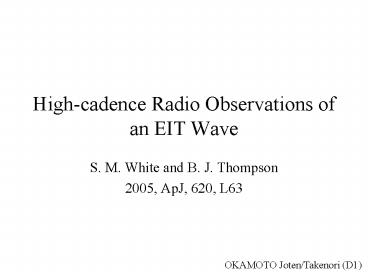Highcadence Radio Observations of an EIT Wave - PowerPoint PPT Presentation
1 / 13
Title:
Highcadence Radio Observations of an EIT Wave
Description:
High-cadence Radio Observations of an EIT Wave. S. M. White and B. J. Thompson ... we cannot measure fast EIT-wave speed because of the short cadence: 12 min ... – PowerPoint PPT presentation
Number of Views:58
Avg rating:3.0/5.0
Title: Highcadence Radio Observations of an EIT Wave
1
High-cadence Radio Observations of an EIT Wave
- S. M. White and B. J. Thompson
- 2005, ApJ, 620, L63
OKAMOTO Joten/Takenori (D1)
2
Abstract
- Radio observations of the 1997 September 24 EIT
wave - The radio spectrum is consistent with optically
thin coronal emission. - No deceleration is observed during the 4 minutes
from the flare onset
3
EIT wave
- EIT stands for EUV Imaging Telescope.
- In 1997, a flare-associated wave was
- Observed with SOHO/EIT.
- Associated with
- -- Moreton waves in Ha
- -- Coronal mass ejections (CME)
- -- Type II radio bursts
- Fe
XII 195Å - Plasma
at 1.5 MK
green/original monochromatic/running difference
4
Uchida model
In 1968, Uchida proposed fast-mode MHD
shock-wave model to explain Moreton waves.
chromosphere Moreton wave (a shock wave
depresses solar chromosphere) corona ???
EIT wave ? (what is a coronal Moreton
wave ?)
model
corona
chromosphere
5
EIT wave ( the other waves)
- EIT wave
- The wave is launched by the impulsive phase of
the flare - It arises in association with CME following the
flare - What is an EIT wave?
- Fast-mode shock wave
- Propagating fronts in soft X-ray images (e.g.
Narukage et al. 2002) - Dark features in He I 10830A (e.g. Gilbert et al.
2004) - Coronal Moreton wave or not (e.g. Thompson et al.
2000, Eto et al. 2002) - Deceleration of wave front over time (e.g.
Warmuth et al. 2001)
6
EIT wave on 1997 September 24 (Thompson et al.
2000)
sharp front
SOHO/EIT
flare site
233 UT
249 UT
303 UT
7
Moreton wave on 1997 September 24 (Thompson et
al. 2000)
303
323
50
49
47
Moreton wave 500 km/s EIT wave 300 km/s
45
EIT
Ha
(EIT)
(Ha)
(Ha)
(Ha)
0245 UT
0247 UT
0249 UT
0250 UT
8
Radio wave
- Difficult to detect
- Two events reported
- A radio feature moving in the same direction as
an EIT wave, but not coincident with it (Aurass
et al. 2002) - A feature moving with a Moreton wave, but no EIT
data (Warmuth et al. 2004)
9
Radio wave event (1999 September 24)
100
No wave
Brightness temperature 5000 K -gt 1000K
The evolution is very similar to that seen in Ha.
The exact time of EIT is uncertain. (2 min)
At 025100 UT -gt identical in position, shape
If so, estimate EM and temperature.
10
Radio wave
The radio wave speed is 835 km/s. The onset time
of the flare is 0247 UT, later than 0243 UT
made by Thompson et al. (2000) on the basis of
Ha. (but, Ha 30 s, 40 uncertainty)
11
Discussion 1
- Production of radio emission
- thermal free-free emission
- Emission region (spectra 17 GHz and 34 GHz)
- optically thin coronal emission (flat spectrum)
- optically thick chromospheric emission (I ??2)
- Density enhancements, not temperature effects
- Temperature increase -gt radio flux decrease (if
density is not changed)
12
Discussion 2
- The EIT wave shows no deceleration over the
almost 5 minutes. - Moreton wave -gt (deceleration) -gt EIT wave ?
- All Moreton waves appear to decrease in velocity
(Warmuth et al. 2004) - 800 km/s in radio for up to 300 s from the flare
onset 0249 0253 UT - 500 km/s Moreton wave between 0247 and 0250 UT
- error of order 3 minutes (Ha) would be needed if
the radio wave is colocated with the Moreton wave.
13
Conclusion
- Radio observations of 1997 September 24 EIT wave
? 830 km/s (gt EIT wave speed 300 km/s) - we cannot measure fast EIT-wave speed because of
the short cadence 12 min - Radio wave appeared at some distance from the
flare site. - Since radio data are sensitive to density
enhancements rather than temperature changes, the
wave phenomenon observed by EIT is not a
temperature effect. - No deceleration is observed while it is visible
in the radio images. - The issue is critical since it is required to
explain why EIT waves have much slower than the
Moreton waves, if they are the same disturbance.































